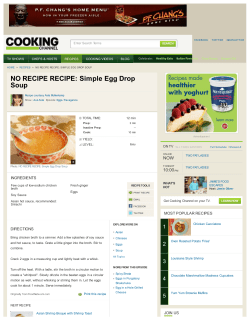
— Using the Menus
2-Week Menus—Overview Using the Menus These sample 2-week menus can be used by any person or family wanting to follow a healthy diet at a modest price. The menus are designed to meet nutrition needs on a budget. All recipes require only kitchen equipment that most people have. Lunches are designed to be packable so they can be taken to work or school. Some lunches use remaining portions from recipes prepared for dinner the night before. Menu items can be moved between daily meals, such as swapping a banana at breakfast for an orange at snack. Snacks can be eaten at any time of the day. In addition, meals can be moved to fit family schedules, such as switching lunch with dinner. • Portion sizes: The amount listed for each food item is the portion for an individual needing about 2,000 calories per day. Portion sizes can be adjusted to the calorie needs and number of people in a household. • Italicized foods: Some foods in the menus are part of a dish rather than eaten alone. They are listed in italics. A food in italics is meant to be eaten as part of the food listed above it. • Bolded foods: SNAP-Ed Recipe Finder recipes are shown in bold on the menu. o Recipe Finder recipes serve four or more people, so they are designed to be prepared for a whole family. o The portion size is not shown—it is the amount listed as one serving on the recipe itself. • Starred recipes (*): These are recipes from the SNAP-Ed Recipe Finder that make eight or more servings. They are used two or more times in the menus. Prepare the entire recipe on the first day it appears and eat the remaining portions as noted on the following days. • Grocery list: The grocery list identifies the amount of food used by a family of four following the entire menu. These amounts may not reflect package sizes found in a particular store. Adjust grocery list amounts for family size and needs, and purchase items in the best size for your family. • Pantry and Staples list: Staple items are foods many people have on hand. Before shopping, check both the grocery and staples lists for all foods needed to prepare the menu. Substitutions are suggested for some items used only once or in small amounts. • Food Safety: Be sure to follow food safety guidelines when preparing and cooking food. Tips for keeping food safe can be found a www.foodsafety.gov. Background • These menus are designed for cost-conscious consumers seeking healthy options. • These menus provide recommended food group amounts for a 2,000 calorie USDA Food Pattern. • They also meet recommended intake amounts for almost all nutrients. In a few cases, the amount in the menu is less than the recommendation but still higher than current intake. o To meet nutritional recommendations and calorie limits, all beverages in the menus should be unsweetened. o To keep sodium amounts within the recommended limit, salt should be used only as specified in recipes.
© Copyright 2025





















